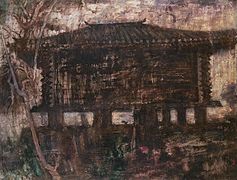Suda Kunitarō
Suda Kunitarō ( Japanese 須 田 国 太郎 ; born June 6, 1891 in Kyoto ; died December 16, 1961 ) was a Japanese painter in the Western Yōga style of the Shōwa period .
life and work
Suda graduated from the Imperial University of Kyoto in 1916, studying philosophy with a focus on aesthetics and art history. While he then continued his academic education, he enrolled in 1917 at the Kansai Art School ( 関 西 美術 院 , Kansai bijutsu-in ) and studied painting. In 1919 he went to Europe, where he continued his education for four years. Most of the time he stayed in Spain, where he regularly attended the Prado in Madrid . There he copied El Greco , Goya and the artists of the Venetian school. He was particularly interested in the subtle differences in the technique of oil painting and the stylistic development of European painting.
After his return to Japan in 1923, Suda gave lectures on art history at his old university, but also in other places. He now painted intensively and had his first solo exhibition in Tōkyo in 1932 - he was already over 40. In 1934 he joined the "Independent Art Association" ( 独立 美術 協会 , Dokuritsu bijutsu kyōkai ) and led an active academic and creative life.
Suda's pictures show a characteristic heaviness with dark brown as the main color, whereby he combined intellectual insight with Far Eastern sensitivity. In 1947 he became a member of the Academy of Arts . His pictures, shown several times at home and abroad, have now been received with great sympathy. In 1955 he received the Mainichi Shinbun newspaper's Great Art Prize . From 1950 Suda was a professor at the Kyōto Municipal Art School ( 京 都市 美術 学校 , Kyōto bijutsu gakkō ), where he exerted a great influence on the younger generation, especially in the Kansai area.
Suda's important works include "The Hōkan-ji Pagoda" ( 法 観 寺塔 婆 , Hōkanji tōba ; 1932), "Dog" ( 犬 , Inu ; 1950), and "Cormorants" ( 鵜 , U ; 1952). - His book "Modern Painting and Realism" ( 近代 絵 画 リ ア リ ズ ム , Kindai kaiga to riarizumu ), in which he presented his theories, was published posthumously in 1963.
photos
Byōdō-in's phoenix hall
Remarks
- ↑ Azekura (校 倉) is an old type of storage facility in the form of a log house, which has been preserved mainly in temples.
literature
- Japan Foundation (Ed.): Japanese Painting in the Western Style, 19th and 20th Centuries. Exhibition catalog, Cologne, 1985.
- Tazawa, Yutaka: Suda Kunitarō . In: Biographical Dictionary of Japanese Art. Kodansha International, 1981. ISBN 0-87011-488-3 .
- Laurance P. Roberts: Suda Kunitarō . In: A Dictionary of Japanese Artists. Weatherhill, 1976. ISBN 0-8348-0113-2 .
Web links
| personal data | |
|---|---|
| SURNAME | Suda, Kunitarō |
| ALTERNATIVE NAMES | 須 田 国 太郎 (Japanese) |
| BRIEF DESCRIPTION | Japanese painter |
| DATE OF BIRTH | June 6, 1891 |
| PLACE OF BIRTH | Kyoto |
| DATE OF DEATH | December 16, 1961 |






